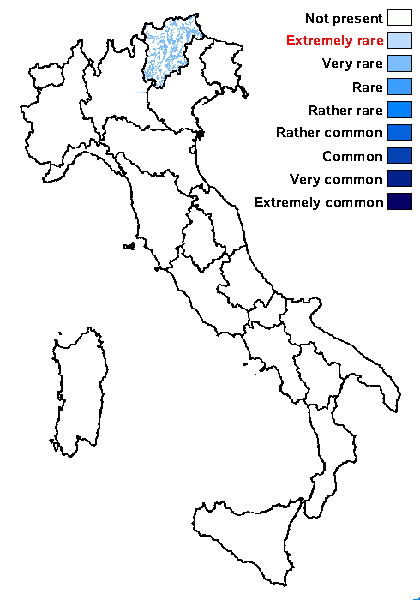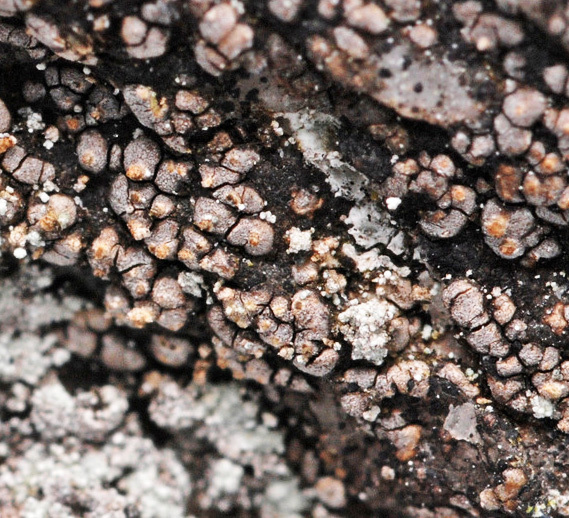Rimularia badioatra (Kremp.) Hertel & Rambold
Bibl. Lichenol., 38: 164, 1990. Basionym: Aspicilia badioatra Kremp. - Denkschr. kgl. bayer. bot. Ges., 4, 2 Abt.: 285, 1861.
Synonyms: Aspicilia corrugatula (Arnold) Hue; Lecanora badioatra (Kremp.) Hepp; Lecanora bockii f. contracta Th. Fr.; Lecanora contracta (Th. Fr.) Zahlbr.; Lecanora corrugatula (Arnold) Nyl.; Lecanora umbriformis (Nyl.) Grummann; Lecidea badioatra (Kremp.) Arnold; Lecidea corrugatula Arnold; Lecidea illita Nyl.; Lecidea insulatula Nyl.; Lecidea umbonatula Nyl.; Lecidea umbriformis Nyl.; Mosigia illita (Nyl.) R. Sant.
Distribution: N - TAA (Nascimbene & al. 2022).
Description: Thallus crustose, episubstratic, rimose-areolate, up to 0.2 mm thick, pinkish brown to dark grey-brown, forming 1-4(-7) cm wide patches, rarely delimited by a dark prothallus. Areoles 0.2-0.5(-1) mm wide, flat to convex, irregularly angular to circular in outline, smooth to granulose. Medulla white, I-. Apothecia apparently lecanorine at least when young, sparse, immersed in the thallus, 0.2-0.4(-0.5) mm across, with a concave to flat, often umbonate, black, epruinose disc and a thin, finally sometimes excluded thalline margin. Thalline exciple rich in algae; proper exciple 30-70 µm thick, dark brown in outer part, paler brown within; epithecium brown, c. 15 µm high, N-, K-; hymenium colourless, 70-100(-110) μm high; paraphyses strongly coherent, branched and anastomosing, 1-1.5 μm thick in lower part, the apical cells up to 3 μm wide; hypothecium dark brown, 50-60 µm high. Asci 8-spored, broadly clavate, the tholus with amyloid flanks and an amyloid cap with vestiges of a narrow, weakly amyloid channel in the upper, central part, Rimularia-type. Ascospores 1-celled colourless to finally brown, broadly ellipsoid, (10-)16-18(-22) x (7-)9-11(-13) µm. Photobiont chlorococcoid. Spot tests: cortex and especially medulla K-, C+ pink , KC+ pink, P-. Chemistry: gyrophoric acid, very rarely also norstictic acid.Note: on steeply inclined surfaces of hard, base-rich or weakly calciferous siliceous rocks, mostly in upland areas but rarely occurring above treeline.
Growth form: Crustose
Substrata: rocks
Photobiont: green algae other than Trentepohlia
Reproductive strategy: mainly sexual
Commonnes-rarity: (info)
Alpine belt: absent
Subalpine belt: absent
Oromediterranean belt: absent
Montane belt: very rare
Submediterranean belt: absent
Padanian area: absent
Humid submediterranean belt: absent
Humid mediterranean belt: absent
Dry mediterranean belt: absent

Predictive model
Growth form: Crustose
Substrata: rocks
Photobiont: green algae other than Trentepohlia
Reproductive strategy: mainly sexual
Commonnes-rarity: (info)
Alpine belt: absent
Subalpine belt: absent
Oromediterranean belt: absent
Montane belt: very rare
Submediterranean belt: absent
Padanian area: absent
Humid submediterranean belt: absent
Humid mediterranean belt: absent
Dry mediterranean belt: absent

Predictive model
 Index Fungorum
Index Fungorum
 GBIF
GBIF


